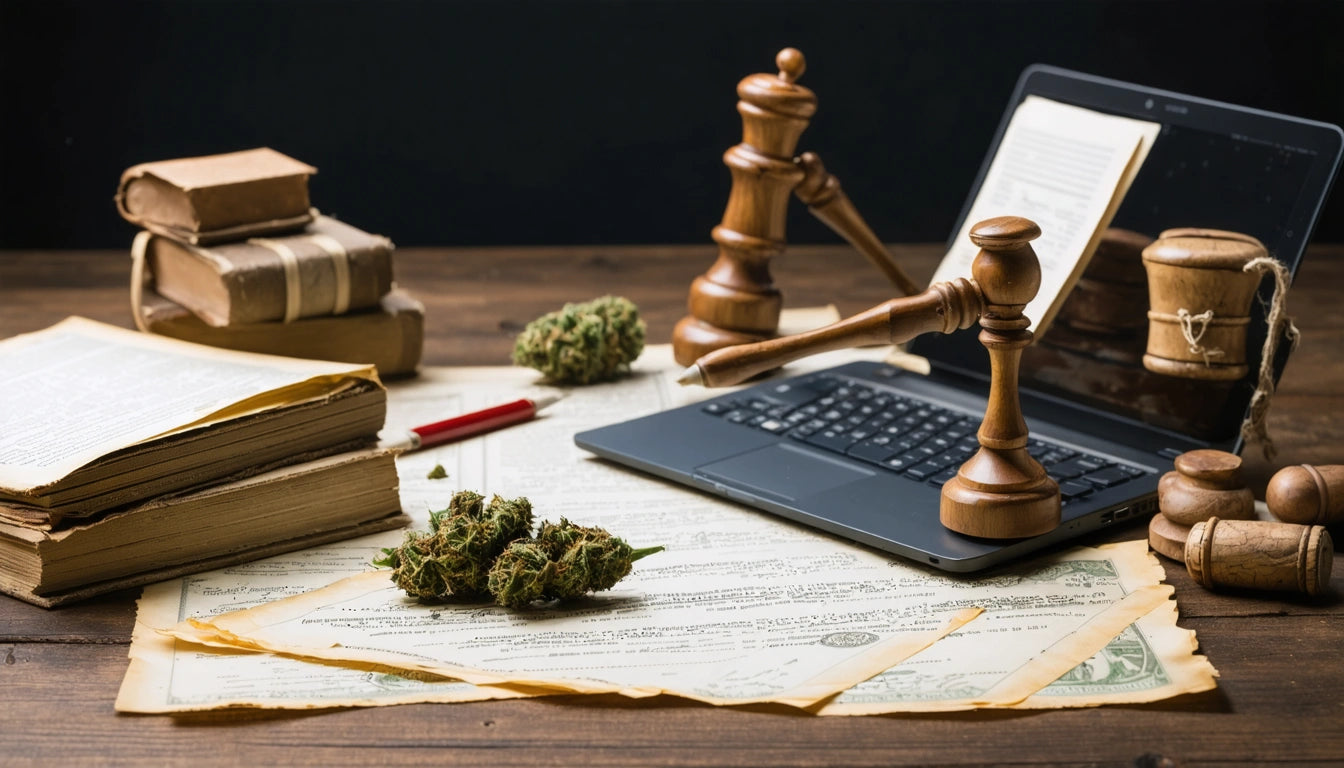Table of Contents
- Early Regulation: The Path to Prohibition (1906-1936)
- Federal Prohibition: The Marijuana Tax Act of 1937
- Stricter Penalties: The Boggs Act and Narcotics Control Act
- The Controlled Substances Act of 1970
- Racial and Economic Factors Behind Prohibition
- The Propaganda Campaign Against Cannabis
- Shifting Perspectives on Marijuana Prohibition
The History of Marijuana Prohibition in the United States: Key Dates and Reasons
The question of when marijuana became illegal in the United States has a complex answer spanning several decades of gradually increasing restrictions. Cannabis prohibition wasn't implemented as a single nationwide ban but evolved through a series of federal and state regulations beginning in the early 20th century. Understanding when weed was made illegal requires examining the social, political, and economic factors that drove its criminalization.
Early Regulation: The Path to Prohibition (1906-1936)
The first significant federal action affecting cannabis came with the Pure Food and Drug Act of 1906, which didn't outlaw marijuana but required labeling of cannabis-containing medicines. This marked the beginning of federal oversight of cannabis products.
Between 1915 and 1927, multiple states began enacting their own prohibitions:
- 1915: California became the first state to prohibit cannabis
- 1916: Wyoming banned cultivation and use
- 1923: New York, Iowa, Oregon, Washington, and several other states criminalized cannabis
- 1927: By this year, 11 states had outlawed marijuana
These state-level prohibitions preceded federal action and were often motivated by anti-immigrant sentiment, particularly targeting Mexican immigrants who were associated with recreational cannabis use. This period saw the deliberate shift in terminology from "cannabis" to "marijuana" to emphasize the drug's foreign origins and stoke xenophobic fears.
Federal Prohibition: The Marijuana Tax Act of 1937
The year 1937 marks when marijuana effectively became illegal nationwide through the passage of the Marijuana Tax Act. While technically a tax law rather than a criminal statute, the act made cannabis effectively illegal throughout the United States by imposing such strict regulations and hefty taxes that legal compliance became nearly impossible.
Harry Anslinger, the first commissioner of the Federal Bureau of Narcotics (FBN), was instrumental in pushing for this legislation. The congressional hearings for the Tax Act lasted just two hours, with only two witnesses opposing the bill—one being a representative from the American Medical Association who objected to the lack of scientific basis for prohibition.
The Marijuana Tax Act required all cannabis handlers to register with the federal government and pay special occupational taxes. Violations could result in five years of imprisonment and fines up to $2,000 (equivalent to over $40,000 today).
Stricter Penalties: The Boggs Act and Narcotics Control Act
In 1951, when concerns about narcotics were escalating, Congress passed the Boggs Act, which established mandatory minimum sentences for drug offenses, including marijuana possession. First-time cannabis possession could result in a minimum sentence of 2-10 years with fines up to $20,000.
The Narcotics Control Act of 1956 further increased these penalties, making a first-time marijuana possession offense punishable by 2-10 years with fines up to $20,000. These harsh penalties reflected the period's association of marijuana with criminality and moral decline.
The Controlled Substances Act of 1970
In 1970, under President Nixon, Congress passed the Comprehensive Drug Abuse Prevention and Control Act, which included the Controlled Substances Act (CSA). This legislation represented a significant overhaul of federal drug policy and formally classified marijuana as a Schedule I substance—the most restrictive category reserved for drugs with:
- High potential for abuse
- No currently accepted medical use
- Lack of accepted safety for use under medical supervision
This classification, which remains in effect today, placed cannabis in the same category as heroin and LSD, and imposed stricter penalties than those for cocaine or methamphetamine. The 1970 act represents the modern foundation of marijuana prohibition in the United States.
As noted in this comprehensive timeline of cannabis legalization, the CSA's scheduling of marijuana has been one of the most persistent and controversial aspects of federal drug policy.
Racial and Economic Factors Behind Prohibition
Understanding why weed was outlawed requires examining the social and racial dynamics of early 20th century America. The criminalization of cannabis was deeply intertwined with racial prejudice and xenophobia:
- Anti-Mexican sentiment in the Southwest, where cannabis use was associated with Mexican immigrants
- Fear of Black jazz musicians in urban areas, who were portrayed as using cannabis and corrupting white youth
- Association of cannabis with "degenerate" behaviors and criminality among minority populations
Harry Anslinger, who led the prohibition effort, openly used racist rhetoric, claiming: "Marijuana causes white women to seek sexual relations with Negroes" and that "most marijuana smokers are Negroes, Hispanics, Filipinos and entertainers."
Economic factors also played a significant role in why marijuana became illegal. Hemp posed a competitive threat to the emerging synthetic fiber industry, particularly nylon, which was patented by DuPont in 1937—the same year as the Marijuana Tax Act. Newspaper magnate William Randolph Hearst, who owned vast timber holdings that could be threatened by hemp paper production, used his media empire to promote anti-cannabis propaganda.
The need for secure packaging solutions that protect children from accidental exposure became a later justification for maintaining strict regulations, though this concern emerged decades after initial prohibition.
The Propaganda Campaign Against Cannabis
A coordinated media campaign helped solidify public opposition to marijuana. The 1936 propaganda film "Reefer Madness" portrayed cannabis as causing violent crime, sexual deviance, suicide, and insanity. Hearst's newspapers ran sensationalistic stories linking marijuana use to violent crimes and moral degradation.
This propaganda campaign successfully rebranded cannabis—previously known primarily as a component in medicines—as a dangerous narcotic that threatened American values and safety. The campaign deliberately used the term "marijuana" instead of the more familiar "cannabis" to emphasize its foreign nature and association with Mexican immigrants.
As detailed in this analysis of weed criminalization history, the scientific community's objections to prohibition were largely ignored in favor of sensationalized accounts and racial fearmongering.
Shifting Perspectives on Marijuana Prohibition
Since the 1970s, understanding of when and why weed became illegal in the United States has evolved alongside changing attitudes toward cannabis itself. The recognition that prohibition was built on questionable foundations has contributed to the modern legalization movement.
In 1972, the National Commission on Marijuana and Drug Abuse (the "Shafer Commission") recommended decriminalizing possession of small amounts of marijuana for personal use—a recommendation rejected by President Nixon. This marked an early official acknowledgment that the original justifications for prohibition might have been flawed.
Today, as states increasingly move toward legalization, the historical context of when marijuana was made illegal and the motivations behind these laws are being reexamined. The racial disparities in enforcement of marijuana laws—with Black Americans nearly four times more likely to be arrested for possession despite similar usage rates across racial groups—highlight the continuing impact of prohibition's discriminatory origins.
Understanding this history provides crucial context for current debates about cannabis policy reform and efforts to address the social inequities created by decades of prohibition that began in the early 20th century and reached its peak with the Controlled Substances Act of 1970.











Leave a comment
All comments are moderated before being published.
This site is protected by hCaptcha and the hCaptcha Privacy Policy and Terms of Service apply.